It has been said that the sleep-doctor’s magic was so powerful that,
when in his presence, even the unbelievers could sometimes see the
images of the spirits who were in the constant company of the great
chief. As far as the white men of the day were concerned, Nicolai was
the true chief of the entire Ahtna people. No one ever again was able to
fill the role which was Nicolai’s alone. His word was final, even for
those who failed to properly recognize his power. We had good reason to
respect the tyone. When Nicolai spoke, his words had the unnerving
effect of becoming predictions or warnings of what lay ahead.
He was the traditional chief in 1910, having long since given up the
demands of the duties of a real chief when it was clear that the white
men were about to take over our land. Just as Hanagita had allowed
Nicolai to take over the title of chief, Nicolai passed his torch over
to his son Goodlataw. The traditional chief is an honorary position. In
his ceremonial role Nicolai would politely listen to anyone who took the
time and the trouble to seek him out. He was much more likely to be
found at the deserted encampment of Taral than at the village of
Chittyna.
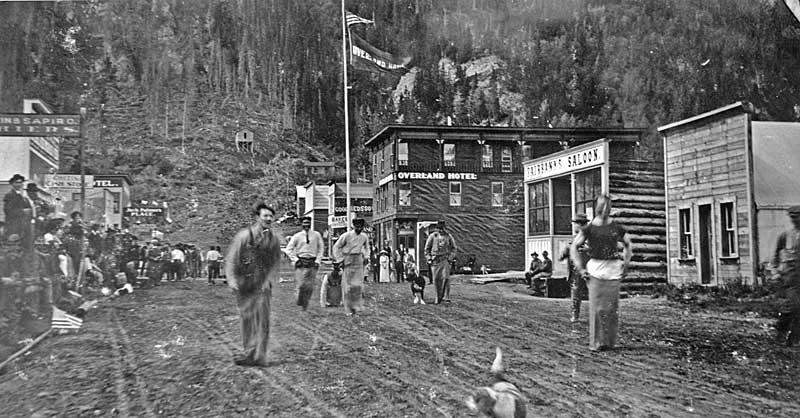 |
Main Street, early Chittyna, 1910-11. --Cordova
Hst Soc #95-72-187 |
Taral was across the river from the railroad construction town of
Chitina. As a raven would fly it was close, but access was difficult
because the confluence of the Chitina and Copper Rivers made it so.
Boats and rafts were rare in those days. Doc Billum had two of them that
he kept near Tonslahti. Taral was just downstream from there. The Copper
was wide and treacherous at this point. It was an area of ceaseless
winds and gusts which carried massive amounts of blasting sand and other
glacial dust which were carried off of the treeless banks lining both
sides of the river in places. It blew so hard that the sand frequently
obscured visibility, rendering river passage extremely hazardous. We
have watched the winds carry the yellowish, finely-grained glacial and
volcanic dust hundreds of feet into the air, rising well above railroad
grade.
The riverbed included many constantly shifting sandbars, but only one
main channel which also tended to shift. If the hazardous part of the
river at the confluence was not skillfully negotiated, one was likely to
inadvertently enter the whirlpool area caused by the meeting of the two
massive rivers. Our boats were too small to avoid being pulled under if
this were to occur. It was always best to stay near the west bank, which
followed the steep cliffs that were blessedly covered by spruce all the
way to river level, instead of being covered by the light sand that
could blow back in our faces.
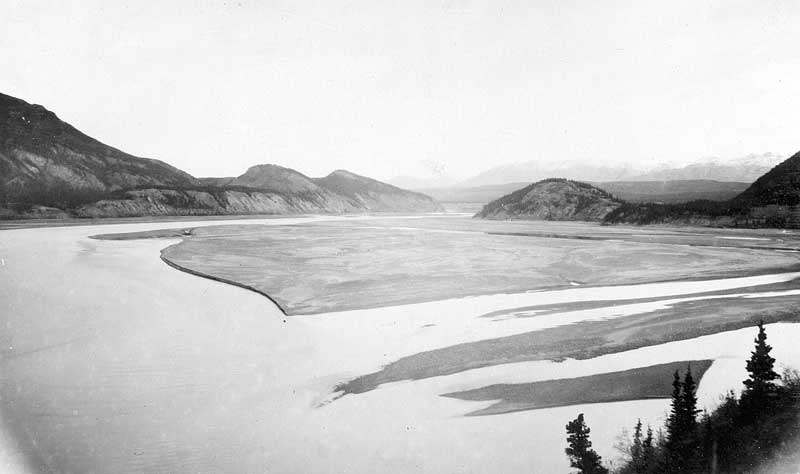 |
Circa 1904 view of the
Copper River looking north (upriver): The Chittyna River
confluence is on the left. The site of Chitina is on the right.
Image taken from just north of Taral --USGS
photo |
The river funneled into the head of Clay Woods Canyon at the point where
Taral Creek entered the Copper River. The grassy and sandy promontory at
Taral Creek gently rose to a low-lying hills where the primitive
structures of Taral have stood and been re-built for maybe a thousand
years or even more.
Since the chief’s death so many years ago, Taral has remained abandoned,
its purposes having been served. It is no longer the lively summertime
fish camp from which forgotten generations of our people would strike
out into the rugged east country toward the vast upper lands of the
mountain glaciers to hunt the great Dall sheep and other animals which
frequented the high grounds. Although our Ahtna people were nomads,
Taral came as close to a permanent settlement as any. It was Taral which
Lieutenant Allen first encountered, no doubt to his great relief, upon
successfully making his way up the Copper River in those early years of
the great western incursion.
Nicolai’s people saved Lieutenant Allen and his small party from
exposure and near-starvation, though that’s not exactly the official
story which has been passed down as history.
In the American west, it was invariably the coming
of the U.S. Army cavalry which brought an end to our Indian brothers’
way of life. First would come the gold seekers, then the fence builders.
With the ranchers came the ket-chee ten-eh thloo-da-kee --the iron trail
machine. As was always the case, the cavalry would enter the scene to
save those miners and other settlers and their iron horses from our
supposedly hostile Indian brothers. In reality, those white people were
on an unstoppable mission to claim our traditional grounds for their own
purposes, even if it meant driving out or killing the Natives who had
lived there from times long forgotten. It was American manifest destiny.
It was we who saved the cavalry in the person of Lt. Henry Allen. The
U.S. Army did not end our way of life here. That role fell to the
railroad which followed a quarter century later. Nicolai lived to see
the first of those machines on iron rails. He was the only one to
proclaim that with the coming of the railroad, our old ways would be
over. He insisted that we would have to adapt to the new ways while
keeping our Indian souls intact by maintaining the best of our
traditions, especially the potlatch--and by sticking together. We would
be lost if we did not act as one.
Nicolai developed a strong but nearly invisible relationship with the
Great Man, Stephen Birch. It was Birch who was behind the mines which
the railway served. Only Stephen Birch was in a position to grant the
tyone what he sought. Nicolai wanted nothing less than the continued
existence of our people on our own lands living by our traditional ways,
with the help of the railroad.
The intrusion of the white man with his great iron machines marked not
so much an ending as the beginning of a whole new and very strange world
to which we would either adapt or we would die. Many among our number
died. It was as simple as that. From that inescapable fact of life there
could be no argument. It simply was. My grandfather feared that it was
he who had opened the way to these “white devil spirits,” as he called
them, first by saving that army scouting party and then, even worse, by
revealing the source of the tsedi to the McClellan party in the year I
was born.
When the tyone first recognized the amount of excitement which the
Nicolai Prospect had generated, he feared a stampede like the gold
rushes of the old west which drove our Indian brothers from their
ancestral lands--those who had already survived the diseases, the
alcohol, and the outright slaughters. Then came the discovery of the
enormously rich Bonanza copper outcropping. Nicolai realized to his
horror that the door had been opened wide for a massive encroachment of
the westerners into his beloved land. Like the mythical Pandora’s box,
it was no longer possible to close that door. Nicolai’s role as tyone
ended with the incursions. He seemed powerless in the face of the
unstoppable forces best expressed with the coming of great iron
machines.
It was in 1900 that the old chief retreated like a hermit to the nearly
abandoned site of Taral to live out the rest of his days in apparent
despondency. Or so it appeared. Nicolai had not been the chief our
Saghani utsuuy clan for so many years because of his own self doubting.
It was not in his nature to stew in self-loathing. In the comfortable
perspective of all these years since my brothers Michael and Charlie and
I sat at that fire in the old camp, I have come to believe that Nicolai
was the right leader for us at the most critical moment. He comprehended
the situation only too well and found within himself the ultimate Native
solution.
It was a very brief, yet hot, dusty summer which had already slipped
into an early fall. The leaves turned early. Snow appeared on the upper
reaches of the foothills surrounding Chittyna. I have always preferred the
old spelling of Chittyna, which was quickly altered to Chitina because
someone, probably that old unrepenting, wholly unreasonable redneck,
Otto Adrian Nelson, thought the spelling looked too Indian. Even though
that original spelling is now largely forgotten, I still use it to differentiate the
Indian village from the white man’s railroad town of Chitina.
The mature town of Chitina & Town
Lake in the late 1930s
Chitina began as a railroad junction. The trestle crossing upriver
marked the beginning of the branch line that terminated at the Bonanza
mine site. The railroad surveyors picked the location of the town site
well. Chitina was just downriver from an easy crossing point to the east
bank. The site is partly protected from the winds and the extreme winter
cold of the river banks 100 feet below, due to tall rocky hills
surrounding the town in all directions. Chitina sat in a natural bowl,
though there were outlets to the south and the west.
The wide, circular shore of Town Lake, originally known as Trout Lake
before the town’s open sewers ruined it, proved ideal as a natural
track-turning circle, enabling the trains to reverse directions at
Chitina, returning to either Kennecott or Cordova as the circumstances
required. As it turned out, the railroad company found it could run two separate
trains on the same single line track because of the large turn-around at
Chitina. The Chitina Local worked the line from Chitina to Kennecott and
return, while the Mainline or Cordova Local ran larger consists from
Cordova to Chitina.
The railroad town of Chitina could not be seen from Taral. Nor could it
be seen from any point along the river because it is hidden behind a
tall mound of shale-like rock towering hundreds of feet above Chitina.
known as Spirit Rock. Thus the natural bowl which was Chitina was
bounded by the 600 foot-tall rock mound and also by the steeply rising
foothills which extended into the Chugach Range, whose 5,000-plus foot
summits were frequented only by sheep and mountain goats.
Even though the view of the town was blocked by Spirit Rock, the glow
from all that construction activity could be seen downriver as far as
Taral. Chitina the construction town was about to become Chitina the
railroad junction. The place was temporarily populated by railroad
construction workers probably numbering into the thousands. Many of
those men stayed at the canvas tent town, just down river from the
trestle crossing. The two 120-foot river steamers were moored at the
landing by the trestle crossing the night we were at Taral. The Tonsina
and the Nizina each held a cargo of timbers and rails picked up at
Abercrombie Rapids Landing at CRNW mile 55. The large, temporary
construction tent-town on the river banks near the crossing took up the
space we customarily used for netting fish. After the camps moved on up
the rails, we placed the first of our new Columbia River style fish
wheels there. Since then, we have always had fish wheels at the site.

|
A CRNW river
supply ship heads down the Copper River through Woods Canyon
--Simpson Files |
On this night the third steamer, the 110-foot Chittyna, had pulled up
along a sand bar near a place later known as Haley Creek, just below
Clay Woods Canyon. This was a wide sandbar that was the location of a
second large construction camp. The relentlessly approaching steel rails
ended near this camp on this early September evening. The constant
blasting in the canyon was a source of irritation to Grandfather, but it
was finally over for the night and all was relatively quiet.
Grandfather believed that we had no choice but to adapt in our own
unique way to the new world of the white man. He saw Chitina as one of
our main spiritual focal points which we Ahtna people must ultimately
reclaim as exclusively our own. For this reason, we have continued to
bury our own in various places close to the old railroad town rather
than in the more remote sites we deserted when the railroad came.
When the first snow arrives, it initially reveals itself at the top of
Spirit Mountain, which is a steep, distinctive peak standing in defiant
magnificence several miles to the south of Taral. Spirit Mountain crowns
a wild region along the east bank of the Copper which extends from the
south bank of the Chitina River, through Taral and beyond to the Bremner
River, just north of a massive ice field this side of the Chugach Range.
The view across the river on the west bank centered on a steep ridge
which towered well above the new Copper River and Northwestern Railway
cut. The railroad grade was about 100 feet above the river level and ran
along a sheer cliff. The irregular cliffs above the rail bed shot in a
swift vertical climb thousands of feet toward summits which only briefly
in the summer were freed of their snow caps.
Spruce followed these rugged slopes only a few hundred feet before
giving way to alpine growth of low brush intermingled with low brush and
brightly-colored flowers of the high meadows which existed among the
steepest of precipices. Mostly, though, the scenery was dominated by
bare, ruggedly eroded rocks which briefly altered their angle of ascent
to gentler angles before resuming another steep climb approaching the
highest summits about five miles from the western bank of the Copper
River.
The low foothills were sharply cut with deep ravines. These were usually
choked with rapidly moving mountain streams emanating from the upper
reaches of those lofty mountains of shale. The relative closeness of the
tall foothills opposite Taral concealed the tallest of the peaks from
view. Nevertheless, we could clearly see the beginnings of the snow caps
on the closest of the high summits threatening to soon bring the full
force of winter upon us that early September of 1910.
The Copper River has always been the center of our existence. Even in
the years when the hunting was not so productive, we could always count
on the salmon from that river for our sustenance. The Copper River ran
through eighty miles of a buffer area which all the Native groups
respected as no-man’s land. Beyond that, it eventually led into the land
of the Eyaks, the Chugach and the Tlingits--our traditional trading
partners for as long as we have had tsedi to trade. Some of our own
people are said to be from among the Tlingits, having given up their
rich coastal way of life for our much more rugged and primitive interior
lifestyle. The custom of the potlatch which we have long since adopted
as our own probably came from our Tlingit brethren.
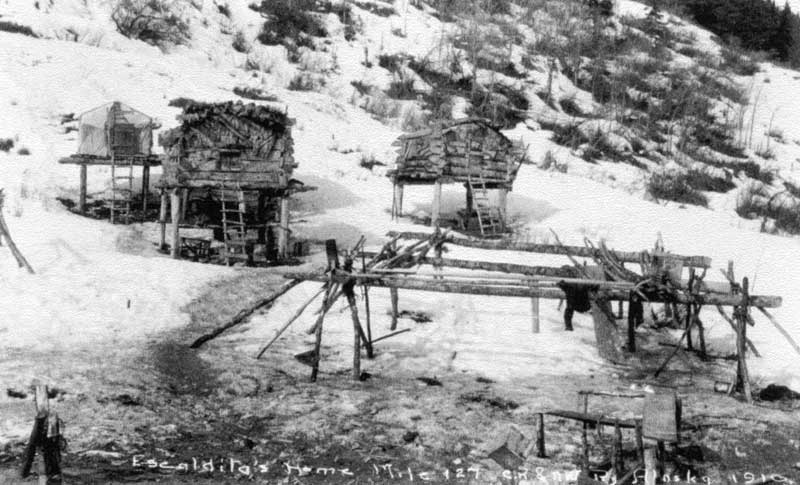
Eskilida Fish Camp across the Copper River from Taral --Candy Waugaman Collection
Before the white man came, many fish camps existed along the east bank
of the Copper. All that quickly changed after the turn of the century.
Even Taral--the most famous of them all--would quickly be deserted. The
government schools and the trading posts were all built on the west
bank. This was only the beginning of the changes. Some of the Native
fish camps on the west bank, including old man Eskilida’s place along a
stream named after him at CNRW mile 127 existed when the railroad
arrived. For every stream entering the Copper there would be a
corresponding fish camp. Eskilida’s was the closest one to the new
construction town of Chitina at CRNW mile 131 in 1910. Some of our
ancestors were buried at CRNW Mile 127. The railroad survey went right
through the burial grounds. This would later prove to be a source of
major conflict between the railroad company and us.
Chitina boasted the first of a small number of government schools which
had been especially established for our people. All these schools were
on the east bank of the Copper, from Chitina to Copper Center, to
Gulkana and all the way up the river to Chistochina.
The three of us boys would be returning to the government school soon.
For the moment we would be able to experience this last glimpse of a
rapidly fleeting summer before the full force of winter descended upon
us. What a memorable occasion this was to become. The event was a
pivotal moment for all three of us. We were about to hear Grandfather’s
story of the beginning of humankind and of our great mountains as it was
related within his own elaborate version of the Raven Story of Creation.
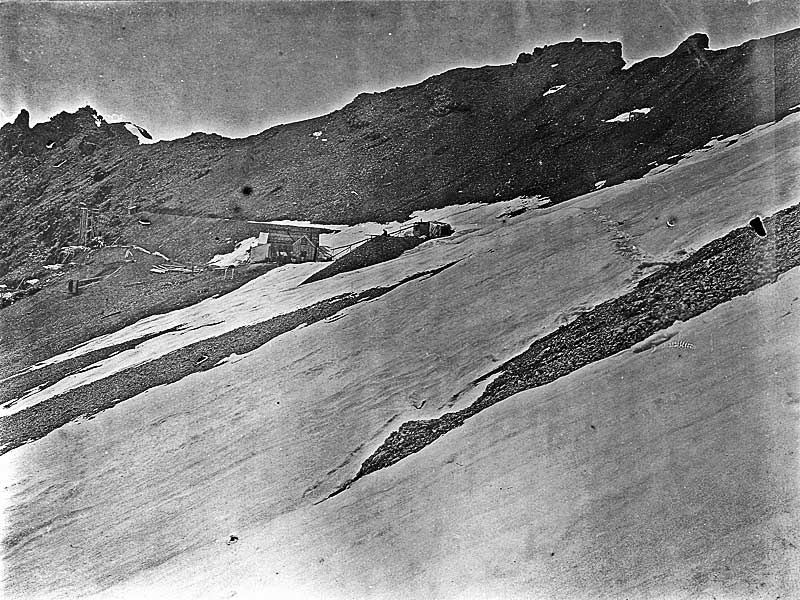 |
"Where it
all started"--The Bonanza Mine under development in 1907.
With the discovery of a major copper vein at this site, the old
world of the Ahtnas was doomed --USGS photo |
|
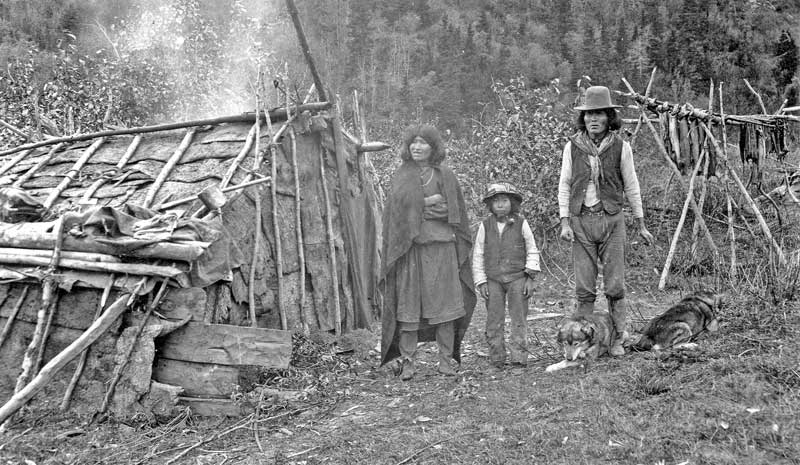 |
This photo was identified as "Camp 32, one mile north of Taral,"
shows Chief Eskilida and possibly young Cap Goodlataw, ~1898.
--USGS photo |
|
No comments:
Post a Comment